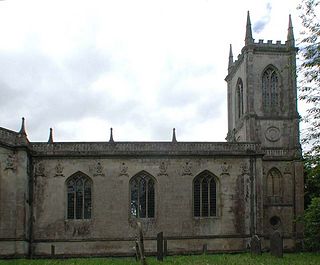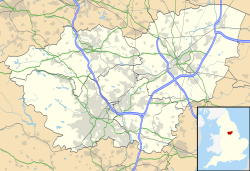
All Saints' Church is a 15th-century redundant church in the park of Harewood House, the seat of the Lascelles Earls of Harewood, near the village of Harewood, West Yorkshire, England. It is recorded in the National Heritage List for England as a designated Grade I listed building, and is under the care of the Churches Conservation Trust. The church stands in isolation within Harewood Park, as the surrounding village was relocated by the owner of Harewood House, in about 1760, to a location further from the house. Inside the church is the family vault of the Earls of Harewood and a set of six alabaster monuments, which are "the largest collection of alabaster monuments in a parish church within the dates 1419–1510".

St Oswald's Church is a redundant Anglican church in Kirk Sandall, near Doncaster, South Yorkshire, England. It is recorded in the National Heritage List for England as a designated Grade II* listed building, and is under the care of the Churches Conservation Trust.

Holy Trinity Church is a redundant Anglican church in the village of Coverham, North Yorkshire, England. It is recorded in the National Heritage List for England as a designated Grade II* listed building, and is under the care of the Churches Conservation Trust. The church stands near the ruins of the Premonstratensian Coverham Abbey, and not far from the River Cover.

Holy Trinity Church is a redundant Anglican church on Low Lane in the village of Wensley, North Yorkshire, England. The building is recorded in the National Heritage List for England as a designated Grade I listed building, and is under the care of the Churches Conservation Trust. Alec Clifton-Taylor included the church in his list of 'best' English parish churches.

St Peter's Church is a redundant Anglican church in the village of Wintringham, North Yorkshire, England. It is recorded in the National Heritage List for England as a designated Grade I listed building, and is under the care of the Churches Conservation Trust. The architectural historian Nikolaus Pevsner described the building as "the most rewarding church in the East Riding with an exceptional collection of furnishings".

St Martin's Church is a redundant Anglican church in the village of Whenby, North Yorkshire, England. It is recorded in the National Heritage List for England as a designated Grade II* listed building, and is under the care of the Churches Conservation Trust.

St Michael's Church is a redundant church in the village of Cowthorpe, North Yorkshire, England. It is recorded in the National Heritage List for England as a designated Grade I listed building, and is under the care of the Churches Conservation Trust.

All Souls Church, Halifax, is a redundant Anglican church in Haley Hill, Halifax, West Yorkshire, England. It is recorded in the National Heritage List for England as a designated Grade I listed building, and is under the care of the Churches Conservation Trust. The church is open to visitors at limited times.

Old Christ Church is a redundant Anglican church located in Waterloo Road, Waterloo, Merseyside, England. The church is recorded in the National Heritage List for England as a designated Grade II* listed building, and is under the care of the Churches Conservation Trust. It was declared redundant in 1982, and its functions have been replaced by a new Christ Church at the junction of Crosby Road South and Alexandra Road, Waterloo.

Holy Trinity Church is a redundant Anglican church in the village of Blatherwycke, Northamptonshire, England. It is recorded in the National Heritage List for England as a designated Grade II* listed building, and is under the care of the Churches Conservation Trust. It stands in the grounds of the demolished Blatherwycke Hall.

St Bartholomew's Church is a redundant Anglican church in the village of Richard's Castle, Herefordshire, England. It is recorded in the National Heritage List for England as a designated Grade I listed building, and is under the care of the Churches Conservation Trust. It stands close to the castle of the same name as the village, which was built to command this part of the Welsh Marches. The village is partly in Shropshire and the county boundary is not far from the church.

St Peter's Church is a redundant Anglican church standing in an isolated position in the civil parish of Wolfhampcote, Warwickshire, England. Since 1960 the church and its attached mausoleum have been recorded in the National Heritage List for England as a designated Grade II* listed building, and are now under the care of the Churches Conservation Trust. The church stands in a field which contains a number of mounds. These are partly the remains of the medieval village initially served by the church, which has been deserted village for centuries, partly from disused canal workings, and partly from the remains of a redundant railway line.

All Saints' Church, Spetchley, is a redundant Anglican church adjacent to Spetchley Park, Worcestershire, England. It is recorded in the National Heritage List for England as a designated Grade II* listed building, and is under the care of the Churches Conservation Trust.

St Leonard's Church is a redundant Anglican church in Bridgnorth, Shropshire, England. It is recorded in the National Heritage List for England as a designated Grade II* listed building, and is under the care of the Churches Conservation Trust.

St Mary Magdalene's Church is a redundant Anglican church near the village of Stapleford, Leicestershire, England. It is recorded in the National Heritage List for England as a designated Grade I listed building, and is under the care of the Churches Conservation Trust. It is situated in the grounds of Stapleford Park.

All Saints Church, Saltfleetby, is a redundant Anglican church in the village of Saltfleetby All Saints, Lincolnshire, England. It is recorded in the National Heritage List for England as a designated Grade I listed building, and is under the care of the Churches Conservation Trust. The church stands in the marshland of Lincolnshire, and has a leaning west tower.

St Lawrence's Church is a redundant Anglican church in the parish of Snarford, Lincolnshire, England. It is recorded in the National Heritage List for England as a designated Grade I listed building, and is under the care of the Churches Conservation Trust. The church stands to the north of the A46 road between Market Rasen and Lincoln. It is a medieval building containing impressive 16th- and 17th-century monuments.

Holy Trinity Church is a redundant Anglican church in the town of Halstead, Essex, England. It is recorded in the National Heritage List for England as a designated Grade II* listed building, and is under the care of the Churches Conservation Trust. The church stands to the north of the junction between Trinity Street and Chapel Hill.

St Laurence's Church stands at the corner of Chapel Street and Edward Street in Morecambe, Lancashire, England. It is a redundant church, formerly an Anglican parish church. Its benefice has been united with that of Holy Trinity, Morecambe. The former church is recorded in the National Heritage List for England as a designated Grade II listed building.

St Leonard's Church is in the hamlet of Linley, Shropshire, England. It is a redundant church under the care of the Churches Conservation Trust. When it was in active use, the church was an Anglican parish church in the deanery of Telford Severn Gorge, the archdeaconry of Ludlow, and the diocese of Hereford. Its benefice has been united with those of All Saints, Broseley, St Bartholomew, Benthall, St Giles, Barrow, and St Mary, Jackfield. The church is recorded in the National Heritage List for England as a designated Grade I listed building.





















